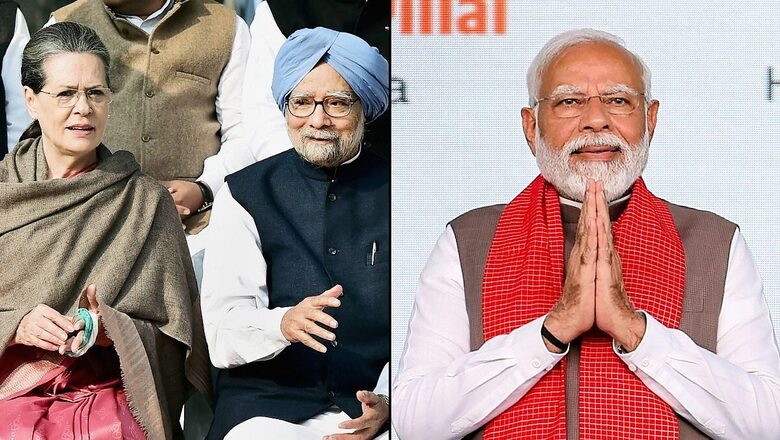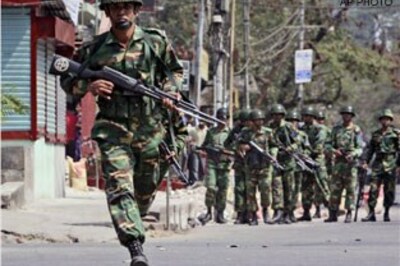
views
The Opposition propagating false accusations against the Modi government through various social media influencers is hogwash and is politically maleficent to cover up the UPA’s scam-ridden financial imprudence. The UPA’s corruption is way beyond the figures of any imaginable bribes and scammed money which crippled the economy. The 10-year stint of the UPA government (2004-14) can be considered a lost decade in terms of potential, opportunities, economic growth and inclusive development, leading the economy to slip deep with an abysmal report.
This period is characterised by various policies that hurt growth, increased corruption on the conflict over land, rent-seeking, unprecedented corruption in the infrastructure and mining sectors, the inability of public education to keep up with increased demands and rising aspirations and the poor delivery of public welfare schemes.
The fact which is indefensible by the Congress as well, the UPA inherited an economy that was growing at 7 per cent in 2004-05, and what it bequeathed to the Modi government: (1) a growth slowdown, a growth rate that is below 5 per cent, (2) “perilous state” of public finances with very high levels of fiscal deficit, much higher than what was shown as pointed out by Vijay Kelkar, for which subsequently the UPA government ended up borrowing 27 per cent more from the market than what it had estimated in the Budget of FY 2011-12, (3) depreciating currency and (4) high rate of inflation.
The Opposition which is slamming the present dispensation on the electoral bonds, calling it the biggest scam and “corporate-political nexus”, has forgotten the UPA era financial impropriety, wherein bad loans during the UPA regime jumped by 132 per cent as the Congress granted a whopping Rs 36 lakh crore to corporates during their tenure by waiving their loans. Vijay Mallya besides defaulting on a Rs 14,50,000 crore loan was again granted Rs 15,00,000 crore of loan, which logically was lost. In September 2013, the Gross Non-Performing Asset (GNPA) ratio to Public Sector Banks (PSB) including restructured loans was as high as 12.3 per cent, amounting to a whopping Rs 39 trillion by March 2012, largely due to political interference by the UPA government on the lending decisions of the PSBs. Thus, crony capitalism, the nexus between the government and the crony corporates created a compromised banking eco-system.
The GNPA to GDP ratio stood at 4.4 per cent at the end of September 2023, indicating a stable and healthier credit ecosystem by comprehensive measures taken by the Central government and the RBI, leading to an aggregate recovery of Rs 10.16 lakh crore by July 2023. During FY 2004-14 (two stints of the UPA regime), India’s external vulnerability increased by multiples because of over-dependence on external commercial borrowing (ECB), with a compound annual growth rate (CAGR) of 21.1 per cent. On the other hand, under the NDA, during the 9-year period ended FY23, ECB grew at an annual rate of 4.5 per cent. During FY 2004-14, India’s Current Account Deficit (CAD) was as high as 2.3 per cent which has been significantly brought down by the Modi government in the past decade to an all-time low of 1.1 per cent. In the past decade, the Modi government has made India a 4.1+ trillion USD economy against 1.8 trillion USD at the end of the UPA 2.
The total value of pending oil bonds by the end of 2013-14, when the Modi government took over, was Rs 1,34,423 crore. The UPA government has failed to check the rise in the prices of essential commodities, particularly food and fuel prices. It failed to strengthen the TPDS. Insufficient procurement of wheat led to higher costs of wheat and the private traders were given free rein to buy foodgrains from farmers by putting restraints on the FCI, and along with this, a fair MSP was not offered. The UPA regime also put a cut in the allocations of food grains to the states. UPA government encouraged Futures, trading in 25 essential commodities, which resulted in speculations and high price rise of such commodities recording a Retail Inflation Rate as high as 25 per cent. Despite fierce opposition from the BJP, then in the Opposition, the UPA government continued with that.
The principled and methodical approach, with a political will to achieve, is at the core of the success of the Modi dispensation. On the other hand, UPA 1&2 can be considered as the entitlement regime, propagating euphemisms, like rural job guarantee, Universal Right to Education for children between 6-14, Right to Information, food security et al, which failed to fulfil aspirations of most of the Indians.
With a bulging demographic dividend of 65 per cent of its 1.2 billion people being less than 35 years old, what will be historically recorded is not what the UPA did, but what it could have done, by training these youth for gainful employment generation and preparing them for the future. It is not always easy to measure the full “cost of corruption” as it is accountable for inflation, changing currency value, the existence of a parallel economy in the form of black money and other macroeconomic criticalities along with its far-reaching adverse impact on the common people, who are bereft of a sizeable portion of their hard-earned money.
Several scams and corruption charges shook the UPA government. The CAG report on the irregularities in auctioning 194 coal blocks caused a loss of Rs 1.86 lakh crore to the exchequer. In the 2G Scam of 2008, the UPA issued 122 new telecom licences to a number of domestic companies that had little or no experience in the telecom sector, and at a price set in 2001 leading to a loss of Rs 1.76 lakh crore to the government. In the Chopper scam (2012), the Former Indian Air Force Chief, Air Chief Marshal SP Tyagi, was allegedly paid bribes to swing a Rs 3,600 crore deal for procuring 12 choppers from Italian firm Finmeccanica to ferry VVIPS.
In the Tatra Truck scam (2012), the Enforcement Directorate had registered a case under the Prevention of Money Laundering Act (PMLA) in April 2013 against Vectra Chairman Ravi Rishi and a few other firms after former Army Chief Gen VK Singh had alleged that he was offered a Rs 14 crore bribe in September 2010 to clear the purchase of a tranche of 1,676 Tatra trucks for the Army. In 2010, former Commonwealth Games Organising Committee chairman Suresh Kalmadi, an old Gandhi family friend and loyalist, was charged for allegedly cheating, conspiring and causing a loss of over Rs 90 crore to the exchequer in a CWG-related corruption case. The Adarsh controversy had erupted with reports that alleged that the land belonging to the defence had been given away by the state for the society where bureaucrats got themselves flats. It was seen that even politicians and army personnel connived to grab apartments in this plush 31-storey Colaba building overlooking the defence area.
The UPA government had 17 million new formal sector jobs created between 2009-10 and 2011-12, 85 per cent of which offer no employment benefits and social security, according to a report of the International Labour Office. However, with 12 million new people entering the labour force annually, 17 million is a meagre number. Against this, the incumbent Modi government has created nearly 2 crore jobs in nine organised sectors annually. Both CGTMSE and PMEGP have been big catalysts in job creation under the Modi government. In 2013, there were a meagre number of 7,700 startups. Against this in 2024, India with over 98,000 startups, has become the world’s third-largest startup destination and over 111 Unicorns, thus creating gainful employment along with self-employment facilities for the aspirational youth. Another big evidence of the creation of gainful employment is the effective alleviation of poverty in India. The number of people living in extreme poverty — defined by the World Bank as living on $1.9 or less in purchasing power parity (PPP) terms — stood only at 0.8 per cent of the total population in 2019, as per IMF data published in April 2022.
UPA government, despite spending from mid-2014 to September 2018 a staggering amount of Rs 4996.61 crore siphoning away from public money (Bureau of Outreach and Communication through a Right to Information application) in advertisement, the voting patterns were reset in 2014 and 2019 in such a manner that Modi is set to return for the third term.
The BJP’s astounding success in 2014 was due to two factors – (a) the people of India chose to oust the scammers in the form of the UPA government and (b) the BJP chose Narendra Modi as its prime ministerial candidate, a leader who quickly became so extraordinarily popular that he was able to create an electoral wave that propelled the party further ahead in the 2019 general elections with a record vote share of 37.36 per cent of the vote, the highest by a political party since the 1989 general elections, and won 303 seats, further increasing its substantial majority.
To continue with the process of development and inclusive growth story, India needs a conscientious and citizen-centric government under PM Modi again for the third consecutive term.
The author is a senior faculty in the Department of History, ARSD College, University of Delhi. Views expressed in the above piece are personal and solely those of the author. They do not necessarily reflect News18’s views.




















Comments
0 comment